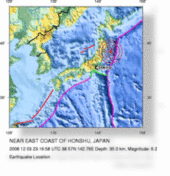
© USGS
Date-Time Wednesday, December 03, 2008 at 23:16:58 UTC
Thursday, December 04, 2008 at 08:16:58 AM at epicenter
Location 38.566°N, 142.762°E
Depth 35 km (21.7 miles) set by location program
Distances 170 km (105 miles) ENE of Sendai, Honshu, Japan
190 km (120 miles) SE of Morioka, Honshu, Japan
220 km (140 miles) ENE of Fukushima, Honshu, Japan
420 km (260 miles) NE of TOKYO, Japan
Comment: For additional reading on the Climate debate: Climate Change Swindlers and the Political Agenda, Fire and Ice: The Day After Tomorrow and Forget about Global Warming - We're One Step From Extinction!.